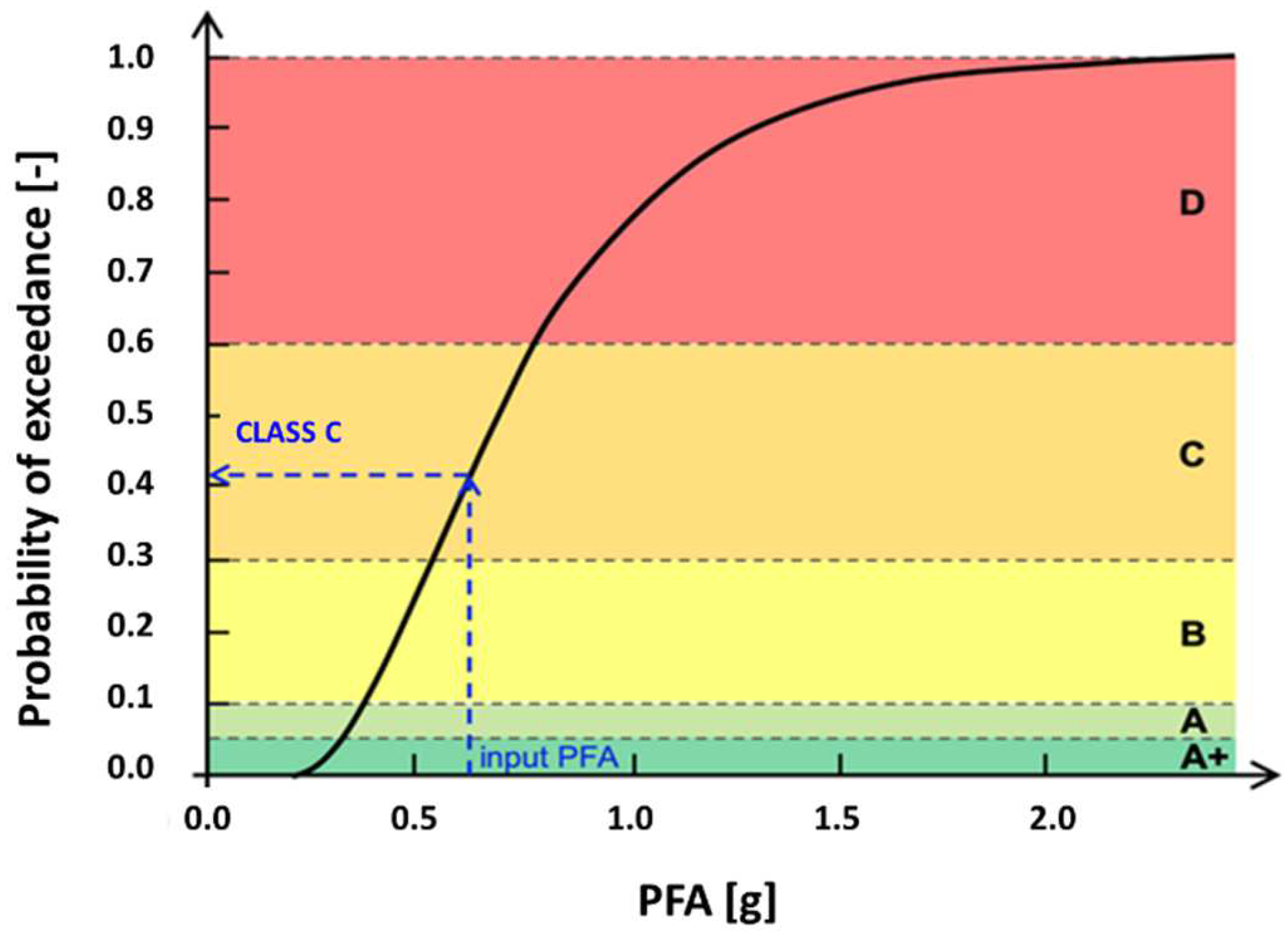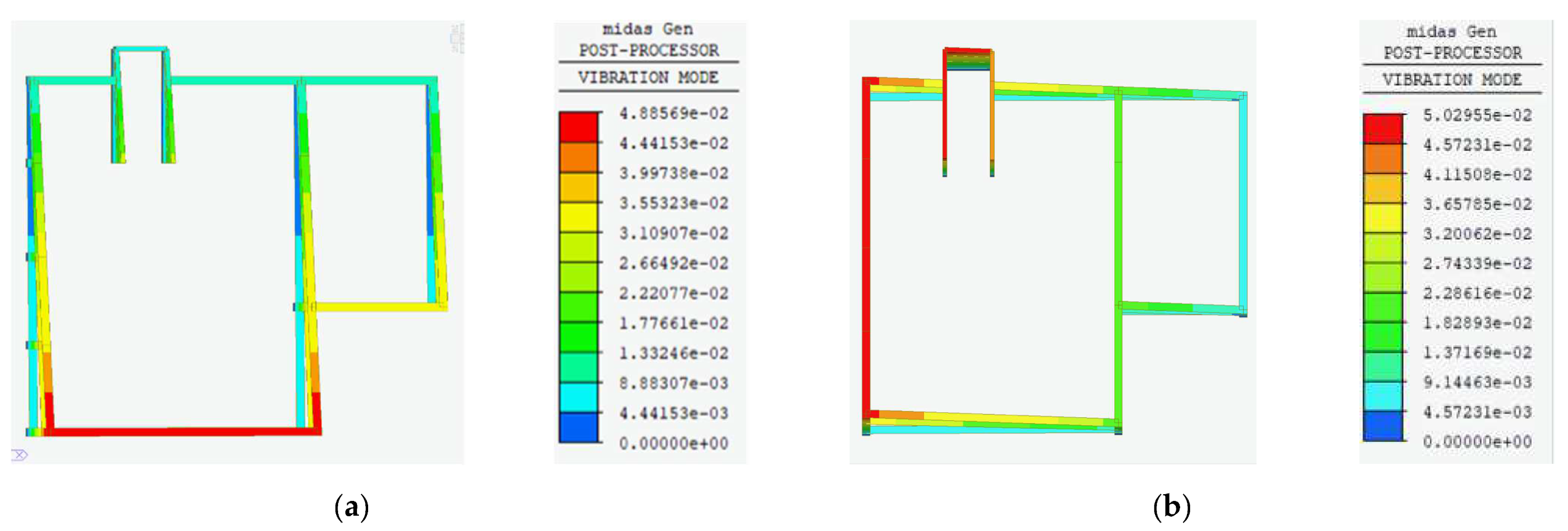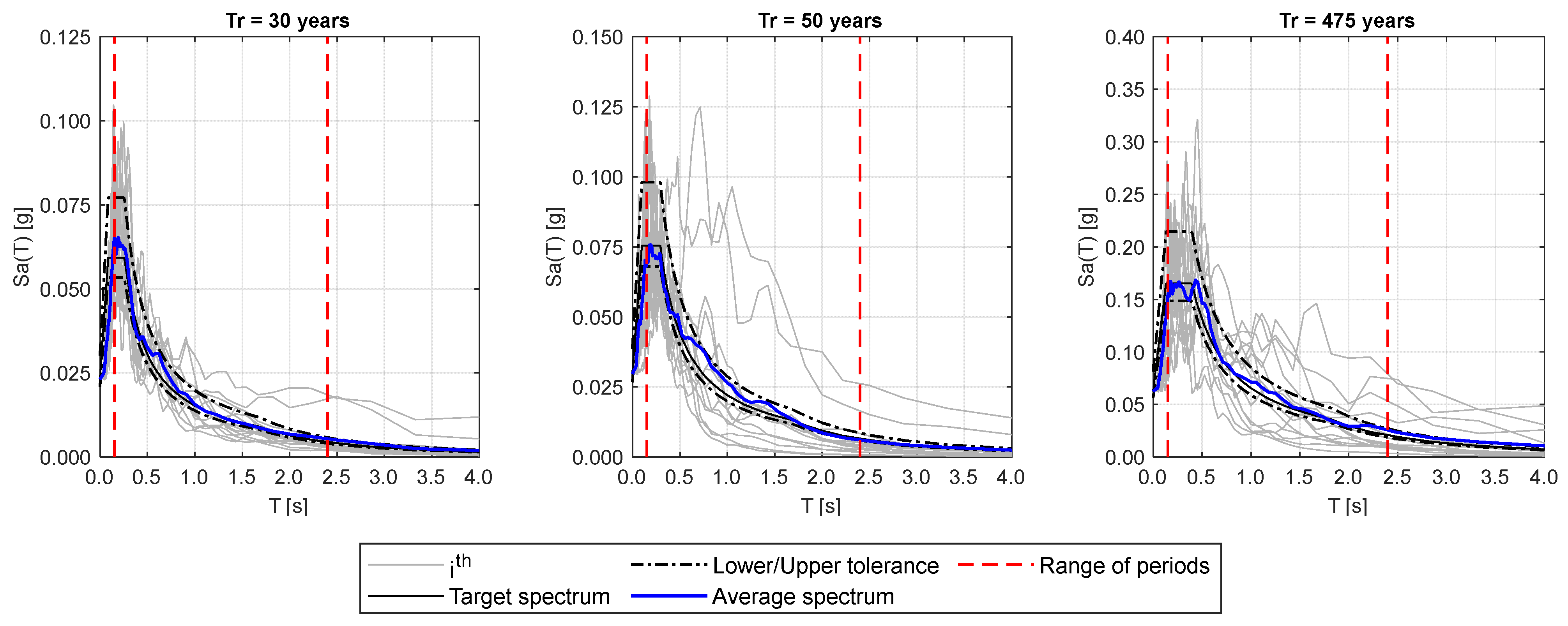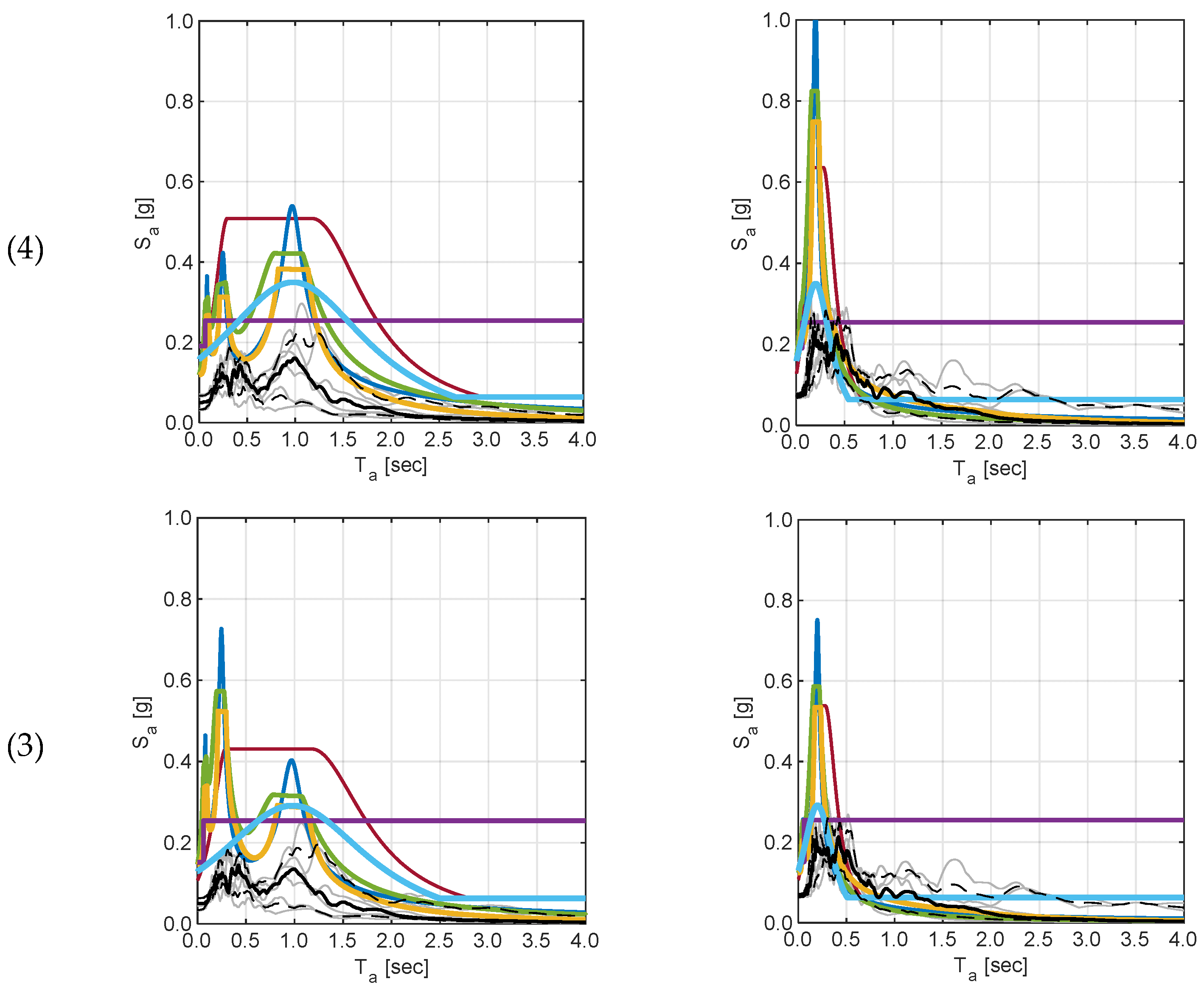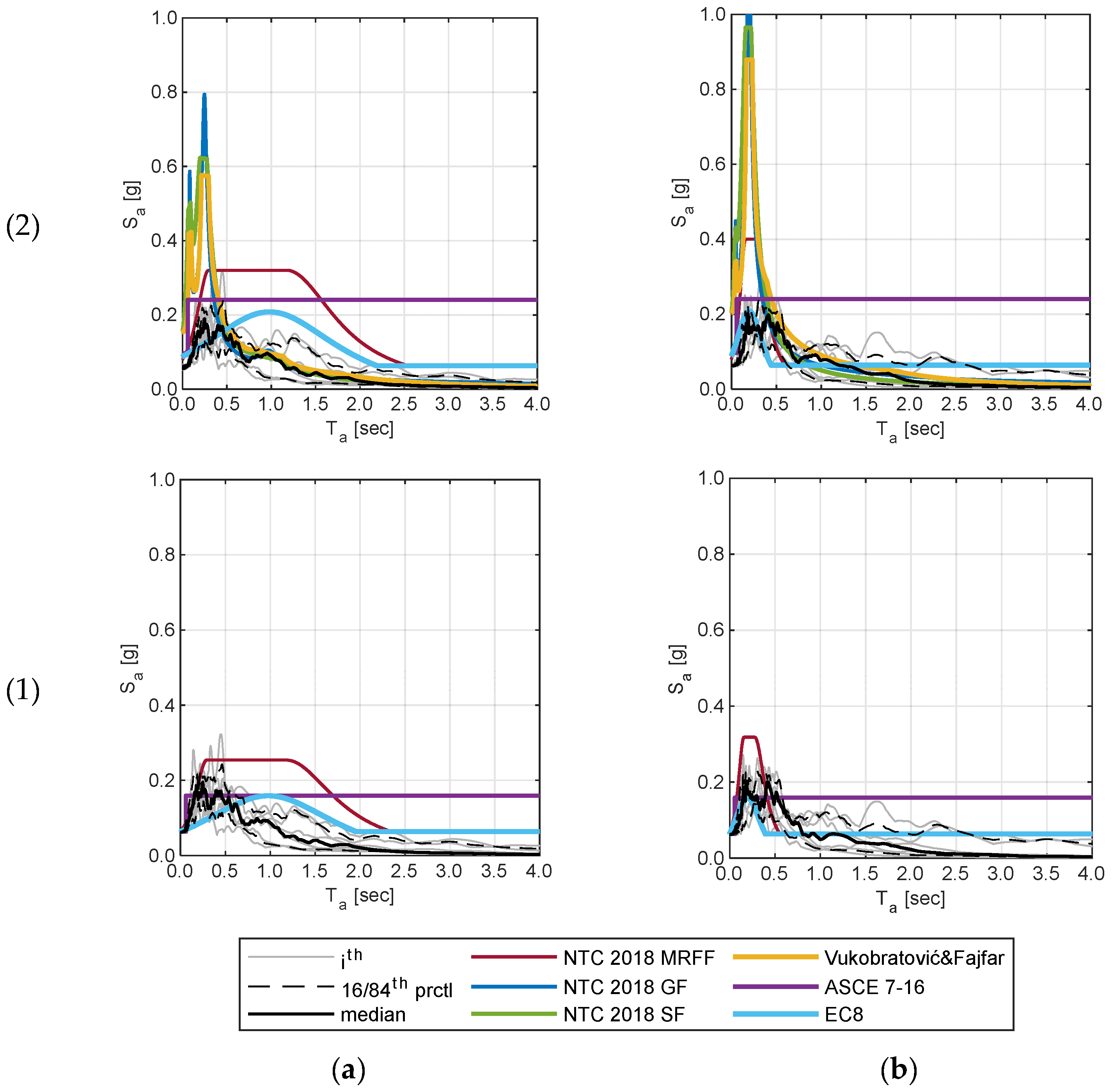The feasibility of the proposed procedure was tested by applying it to an existing case study building, with the aim also of calibrating the probability intervals identifying the different seismic classes.
4.2. Modal and Time History Analyses
To identify the dynamic characteristics of the structure, modal analyses were carried out, providing the results summarized in
Table 3, referring to unit A of the building. The table reports in particular values of vibration periods and corresponding modal masses and cumulative masses in the three directions for the different modes of unit A.
Figure 5 shows modal deformations associated with the fundamental mode in the X direction (
Figure 5a, mode 1) and with the first mode in the Y direction (
Figure 5b, mode 4), identified as the two modes with the highest modal mass in each direction. It should be noted that mode 2 exhibits a significant participant mass in the rotational Z direction. Most likely, this is caused by the effect of stiffness irregularity in the plan caused by the presence of the stairwell.
Time history analyses were carried out to evaluate the amplification of the ground motion induced by the structural response. The selection of accelerograms for time history analyses of buildings is a rather complex aspect, which is widely discussed in the literature (e.g., [
49,
50,
51]), as the record-to-record variability has a significant impact on the results of time history analyses. In this study, the effect of record selection on the results was not explicitly addressed and it was decided to select seven real accelerograms using the software REXELweb v.1 [
52], with the spectrum being compatible with the elastic acceleration response spectrum at the site, defined according to NTC [
47]. Spectrum compatibility according to the Italian building code requires that the average response spectrum ordinate of the seven selected records, obtained with a damping coefficient of 5%, is not lower by more than 10% or higher by more than 30% than the corresponding spectral ordinate of the reference spectrum, in a range of periods of interest for the building and for the considered return period of the seismic action.
Three return periods were considered, indicated by the Italian code for the assessment of three structural limit states, i.e., the operational limit state (OLS), damage limitation limit state (DLS), and life safety limit state (LSLS), and the corresponding response spectra were defined, assuming soil type B (from Forte et al., [
53]) and flat topographic conditions. A nominal life of 50 years was assumed, which is indicated by NTC for ordinary structures, and a class of use of 2, corresponding to buildings with normal crowding, without dangerous substances, and without any essential public or social function. In such cases, the reference period for the seismic action is equal to 50 years.
Table 4 summarizes the values of the parameters defining the elastic response spectrum according to NTC [
47] for the seismic actions indicated by the code for the assessment of the three considered structural limit states. Please note that the code also considers a collapse limit; however, this was not further considered in this work, since it refers to a collapse of the building, while the focus of this work was on nonstructural elements. The parameter
ag is the peak ground acceleration on rock, while PGA is the value of acceleration at the site, which is assumed to be located on soil type B.
F0 is the amplification of the spectrum plateau with respect to PGA and
T*c is the corner period indicating the end of the constant acceleration portion of the spectrum.
Table 5,
Table 6 and
Table 7 report the main characteristics of the two-component real records selected for the considered return periods of the seismic action by using the software Rexel.
Figure 6 shows the acceleration response spectra of the real accelerograms selected using Rexel and compares their average spectrum (thick blue line) with the reference code spectrum (black continuous line) for the considered limit states.
As already mentioned, accelerograms were selected for the seismic action indicated in the code for assessing three limit states of interest for the structure, identified as the operational limit state (OLS), damage limitation limit state (DLS), and life safety limit state (LSLS), and time history analyses were then carried out to evaluate the amplification at the story level. As discussed in the following, fragility curves describing the seismic performance of nonstructural elements are associated with three nonstructural limit states, identified as the OLS, DLS, and LSLS.
Whereas the definition of operational and damage limit states, referring to nonstructural elements, appears quite trivial, regarding the life safety limit state, it is important to point out that it was defined with reference to occupant safety conditions. This means that a life safety limit state was associated with nonstructural damage conditions threatening the safety of people within the structure. Examples could be the collapse of infills, overturning of massive elements, or even falling of heavy furniture or equipment.
It should be noted that the literature and existing codes do not clearly define the return periods of the seismic action to be adopted for the assessment of nonstructural limit states. The Italian code simply reports a table (Tab. 7.3.III, [
47]) in which the assessment of the stability of nonstructural and plant elements is associated with a structural ultimate limit state. Based on these considerations, it was decided to adopt the same seismic action corresponding to structural limit states for the assessment of the corresponding nonstructural limit states, although the authors are aware of the conceptual gap existing on this issue.
In the following, only results obtained for a seismic action with a return period of 475 years will be presented. In particular,
Figure 7 shows the floor spectra obtained at the different levels of unit A from analyses with the seven selected records and considering 5% damping. The median (black thick line) and 16/84th percentile (black dashed lines) spectra obtained from the records are also compared with the floor spectra calculated according to NTC [
47] and its explanatory commentary [
54], Eurocode 8 [
42], ASCE 7-16 [
55], and the formulation proposed by Vukobratović and Fajfar [
39,
56]. It should be noted that the levels indicated in the figure correspond to those automatically assigned by the software: level one is positioned at the base of the basement, level two is at the base of the ground story, level three is at the base of the first story, and level four is at the top of the first story.
The NTC commentary includes three formulations for the evaluation of floor spectra: a general formulation (GF) described by equation C7.2.3, a simplified formulation (SF) according to equation C7.2.5, and a formulation for framed structures (MRFF) based on equation C7.2.11 [
54].
The comparison of the median spectra at the different levels and the corresponding code floor spectra highlights that in most cases, the code spectra envelop the results of numerical analyses in both directions. The fact that the code floor spectra envelop the results obtained from analyses with a limited set of records is somehow expected, as they are defined to account for different sources of variability, including record-to-record variability, structural characteristics (e.g., irregularity, nonlinear behavior, higher mode effects), nonlinear elements properties, and so on, which are not accounted for or not relevant in the analysis of the single considered case study. This is more evident at the higher stories and in the X direction (plots on the left in the figure). In the Y direction, the periods associated with predominant modes are associated with higher modes. For this reason, the code spectra have an amplification range narrower and higher than the one associated with the X direction.
In the X direction at the first (second) level, the EC8 formulation underestimates the seismic demand in the range of periods between 0.08 (0.12) and 0.55 (0.46) seconds, whereas the ASCE 7-16 formulation underestimates it in the range of periods between 0.15 and 0.45 s. In the Y direction, instead, the EC8 and ASCE 7-16 formulations at the first level underestimate the seismic demand for periods greater than 15 s, whereas MRFF underestimate it between 0.4 and 0.80 s. At the higher stories, there is a range of periods, approximately between 0.45 and 1.2 s, for which the GF, SF, and MRFF formulation spectra systematically underestimate the amplification observed in the time history analyses; this does not occur for the Vukobratović and Fajfar formulation. It should be noted that the GF, SF, and Vukobratović and Fajfar formulations are not able to estimate the seismic demand on the nonstructural elements located at level one, i.e., at the base of the basement. Indeed, the mode shape corresponding to the first level is equal to zero.
The results obtained for unit A of the case study building Indicate that depending on the period of the nonstructural element, the seismic demand evaluated with the code formulation could in some cases be on the safe side, although it could be nonconservative for other cases. This suggests that whenever possible, it is better to develop a numerical model of the building of interest in order to evaluate specific floor spectra.
4.3. Selected Fragility Curves for Nonstructural Element Typologies
The main typologies of nonstructural elements located in the case study building were identified. All rooms have suspended false ceilings, constructed using drywall panels and with integrated lighting elements (
Figure 8a). Two typologies of partitions are used to separate spaces, either achieved with an aluminum structure and glass panels (
Figure 8b) or drywall partitions (
Figure 8c). The furniture in the offices and meeting rooms is standard and includes desktops, cupboards, bookshelves, and electronic equipment, such as monitors, printers, and personal computers (
Figure 8d). There are vending machines (
Figure 8e) and electrical cabinets on each floor (
Figure 8f). The air conditioning system includes fan coils (
Figure 8g) and there are also elevators (
Figure 8h) and obviously piping systems (
Figure 8i).
As already mentioned, the seismic performance of these nonstructural elements was defined by means of fragility curves, meaning for each element typology, appropriate fragility curves were selected among those available in the literature for elements with similar characteristics.
The curves refer to the three nonstructural limit states previously introduced and indicated as the OLS, DLS, and LSLS. If literature curves were provided for different limit state definitions, expert judgement was used to identify a reasonable translation into the three considered levels. It is important to recall that some of these nonstructural elements are mainly sensitive to acceleration, and in this case fragility curves in terms of either PGA or PFA were selected. Some elements are instead sensitive to displacement, drift, or both acceleration and displacement, and fragility curves obviously reflect this behavior, being expressed in terms of the IDR.
The following tables report lognormal parameters (median and lognormal standard deviation) defining the fragility curves of the considered nonstructural element typologies, subdivided into the three categories identified by FEMA E-74 [
57]: architectural elements (ARCH,
Table 8); mechanical, electrical and plumbing elements (MEP,
Table 9); and furniture, fixtures, equipment, and contents (FF&E,
Table 10).
4.4. Seismic Classes Provided by the Proposed Approach for Two Different Cases
The first part of this section presents an example of the application of the proposed procedure to the nonstructural elements of the upper story of unit A of the considered building.
Table 11 reports the values of PGA and PFA corresponding to different return periods of the seismic action, calculated according to the Italian building code. In particular, the values of the PGA are those provided by the code acceleration response spectrum and reported in
Table 3, whereas the values of the PFA are derived as the maximum values between the X and Y directions, obtained from numerical analyses for each return period.
Results corresponding to higher return periods of the seismic action are not reported, as they are typically not of interest for nonstructural elements. For each considered nonstructural element typology, the seismic class is evaluated as depicted in
Figure 2 and
Figure 3, and the results are summarized in
Table 12.
It is immediately evident that for the considered case study building, the seismic classification procedure does not allow one to distinguish the performance results of the different nonstructural elements. Indeed, due to the low seismicity level and the limited dynamic amplification of the building, all types of nonstructural elements are in class A+.
To test the proposed approach in a more interesting context and to make sure that it can be useful in defining a priority ranking for retrofitting interventions on the different nonstructural elements, a further example was created by assuming the considered case study building to be located in a medium-high seismicity site, with soil type B. In this case, the input values in terms of the PGA, PFA, and IDR are reported in
Table 13. For this second case, the specific numerical results of time–history analyses were not available. Therefore, to avoid assumptions of the dynamic amplification of the building in this case and also to demonstrate the applicability of the proposed approach even in case a numerical model of the building is not available, the PFA was estimated using the MRFF formulation of NTC18 [
47] and by applying a factor of 2.0 to the PGA values, i.e., assuming them to be at the upper level of the building.
The IDR was assessed by considering an approach that follows the methodology developed by Miranda et al. [
43] and based on the contribution of the first vibration mode of the structure only. In particular, the IDR of the
jth floor is evaluated as:
where
uj is equal to the lateral displacement at the
jth floor level and
hj corresponds to the interstory height. In particular, the lateral displacement at the
jth floor level was computed as:
where
Γ1 and
Φj are the modal participation factor and the mode shape associated with the first vibration mode of the structure, respectively, and
Sd is the displacement spectrum ordinate corresponding to the fundamental period of vibration of the building
T1. The IDR values obtained for the upper floor are reported in
Table 13.
Table 14 reports the seismic classes estimated for each limit state and the final seismic risk class for each nonstructural element, for the case in which the case study building is assumed to be located at a medium-high seismicity site.
In this case, the proposed approach provides greater variability of the assigned classes, suggesting how the proposed classification scheme may help in assigning priorities to the different nonstructural elements requiring seismic upgrading. Indeed, the elements with a lower seismic class (in this example, class D), i.e., glazed elements and large diameter piping, should be the first to be retrofitted, followed by elements in class C and so on. Nonstructural elements falling in class A+ have a negligible probability of exceedance of the considered limit states, meaning they do not require any seismic retrofitting when installed in the building considered as an example.
This second application example also shows that a given nonstructural element typology could be assigned to different seismic risk classes, depending on the seismic hazard of the site of interest, the dynamic amplification due to the structural response, the dynamic characteristics of the building, and the height at which the element is installed.

